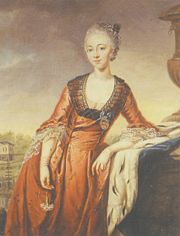
William, Count of Schaumburg-Lippe
Encyclopedia
.jpg)
County
A county is a jurisdiction of local government in certain modern nations. Historically in mainland Europe, the original French term, comté, and its equivalents in other languages denoted a jurisdiction under the sovereignty of a count A county is a jurisdiction of local government in certain...
of Schaumburg-Lippe
Schaumburg-Lippe
Schaumburg-Lippe was until 1946 a small state in Germany, located in the present day state of Lower Saxony, with its capital at Bückeburg.- History :...
-Bückeburg, and an important military commander in the Seven Years' War
Seven Years' War
The Seven Years' War was a global military war between 1756 and 1763, involving most of the great powers of the time and affecting Europe, North America, Central America, the West African coast, India, and the Philippines...
.
Biography
He was born in LondonLondon
London is the capital city of :England and the :United Kingdom, the largest metropolitan area in the United Kingdom, and the largest urban zone in the European Union by most measures. Located on the River Thames, London has been a major settlement for two millennia, its history going back to its...
the son Albrecht Wolfgang, Count of Schaumburg-Lippe and his first wife Countess Margarete Gertrud of Oeynhausen (1701–1726), a daughter of George I of Great Britain
George I of Great Britain
George I was King of Great Britain and Ireland from 1 August 1714 until his death, and ruler of the Duchy and Electorate of Brunswick-Lüneburg in the Holy Roman Empire from 1698....
and his mistress
Mistress (lover)
A mistress is a long-term female lover and companion who is not married to her partner; the term is used especially when her partner is married. The relationship generally is stable and at least semi-permanent; however, the couple does not live together openly. Also the relationship is usually,...
Ehrengard Melusine von der Schulenburg
Ehrengard Melusine von der Schulenburg, Duchess of Kendal and Munster
Ehrengard Melusine Baroness von der Schulenburg, Duchess of Kendal and Duchess of Munster was born at Emden near Magdeburg. Her middle name was probably given in reference to the Melusine legends. Her brother was Marshal Johann Matthias von der Schulenburg...
.
He accompanied his father in his campaign in Dutch service during the War of Austrian Succession, and was present at the Battle of Dettingen
Battle of Dettingen
The Battle of Dettingen took place on 27 June 1743 at Dettingen in Bavaria during the War of the Austrian Succession. It was the last time that a British monarch personally led his troops into battle...
. He then fought in Austrian service in their Italian campaign. He succeeded his father as Count on the 25 October 1748.
Seven Years War
As Count he sided with PrussiaKingdom of Prussia
The Kingdom of Prussia was a German kingdom from 1701 to 1918. Until the defeat of Germany in World War I, it comprised almost two-thirds of the area of the German Empire...
during the Seven Years' War
Seven Years' War
The Seven Years' War was a global military war between 1756 and 1763, involving most of the great powers of the time and affecting Europe, North America, Central America, the West African coast, India, and the Philippines...
. He distinguished himself at the head of the allied artillery during the Battle of Minden
Battle of Minden
The Battle of Minden—or Thonhausen—was fought on 1 August 1759, during the Seven Years' War. An army fielded by the Anglo-German alliance commanded by Field Marshal Ferdinand, Duke of Brunswick, defeated a French army commanded by Marshal of France Louis, Marquis de Contades...
, and was rewarded with the overall command of the allied artillery.
Portugal
In 1762 he led, at the request of the Marquis of Pombal the allied troops in Portugal against the Spanish invasionSpanish invasion of Portugal (1762)
The Spanish invasion of Portugal, between 9 May and 24 November 1762, was the principal military campaign of the Spanish–Portuguese War, 1761–1763, which in turn was part of the larger Seven Years' War...
. William conducted a brilliant defensive campaign of marches and counter-marches, so that the enemy, although three-to-one superior in numbers, were always confronted by defenders in a good position and never dared to risk an all-out attack. At the request of Pombal, Lippe stayed on for a year after the peace agreement to rebuild and train the Portuguese army to a more professional standard.
He was also an influential military theorist, an advocate of defensive warfare. One of best-known citations is : "Kein anderer als der Defensivkrieg ist rechtmäßig!" ("Only defensive warfare is justified!")
He died at Wölpinghausen
Wölpinghausen
Wölpinghausen is a municipality in the district of Schaumburg, in Lower Saxony, Germany....
and was succeeded by his cousin the count of Lippe-Alverdissen
Lippe-Alverdissen
Lippe-Alverdissen was a county in Germany. It was created in 1613 following the death of Count Simon VI of Lippe, with his realm being split between his three sons with his youngest son Philipp receiving the territory of Lippe-Alverdissen....
, Philipp II. Ernst. As one of the greatest figures in German history, he is commemorated by a bust in the Walhalla temple
Walhalla temple
The Walhalla temple is a hall of fame that honors laudable and distinguished Germans, famous personalities in German history — politicians, sovereigns, scientists and artists of the German tongue". The hall is housed in a neo-classical building above the Danube River, east of Regensburg, in...
.
Family

Stadthagen
Stadthagen is the capital of the district of Schaumburg, in Lower Saxony, Germany. It is situated approx. 20 km east of Minden and 40 km west of Hanover. The city consists of the districts Brandenburg, Enzen-Hobbensen, Hörkamp-Langenbruch, Krebshagen, Obernwöhren, Probsthagen, Reinsen...
to Countess Marie Barbara Eleonore of Lippe-Biesterfeld (1744–1776).
They had two children:
- Countess Emilie (1771–1774)
- Unnamed son (1772-1772)

